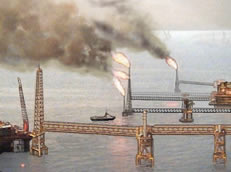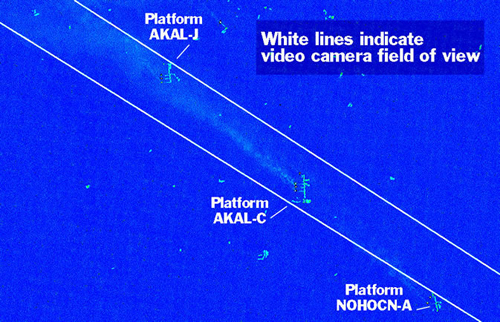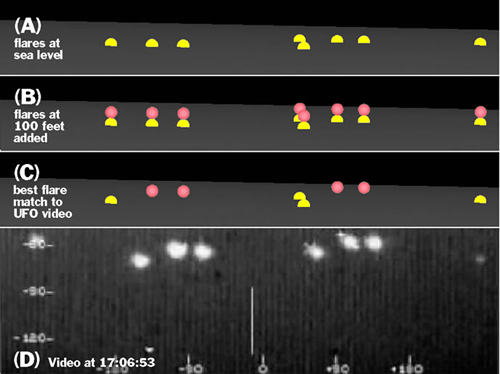The Mexican Air Force UFO Affair:
Aliens, Ball Lightning, or Flares?
by James C. Smith,
an aerospace engineer in Fairfax, Virginia.
On Friday, March 5, Mexican Air Force pilots filmed 11 unidentified flying objects in the skies over southern Campeche state, but the public was not notified of the sightings until Mexico’s Defense Department issued a statement to that effect on May 12. A press release was accompanied by a videotape that showed some bright objects resembling sharp points of light moving rapidly in what appeared to be a late-evening sky. The lights were filmed by pilots using infrared equipment during a surveillance mission in search of drug-smuggling planes. They were reportedly flying at an altitude of about 11,500 feet.
“Was I afraid? Yes. A little afraid because we were facing something that had never happened before,” said radar operator Lt. German Marin in a taped interview quoted in the press release. “I couldn’t say what it was … but I think they’re completely real,” added Lt. Mario Adrian Vazquez, the infrared equipment operator. Vazquez insisted that there was no way to alter the recorded images. The plane’s captain, Maj. Magdaleno Castanon, said the military jets chased the lights “and I believe they could feel we were pursuing them.” He added that when the jets stopped following the objects, they disappeared.
Accounts of what actually happened varied wildly. Skeptic publisher Michael Shermer appeared on CNN three times the week the story broke. “Initial reports indicated that the UFOs were only discovered upon later review of the footage after the flight,” Shermer said. “Subsequent reports stated that the pilots saw the UFOs during the flight, but nothing much was made of it until the infrared footage was later reviewed. Still later reports claimed that the pilots not only saw the UFOs during the flight, but that they chased them, were surrounded by them, but were unable continue the chase. It was like a fisherman’s tale, growing with each retelling.”
The UFOlogists glommed onto the story when a Mexican UFO investigator named Jaime Maussan presented the footage as proof of alien visitation, which he said he obtained from Mexican Secretary of Defense Gen. Ricardo Vega Garcia. “This is historic news,” Maussan told reporters. “Hundreds of videos (of UFOs) exist, but none had the backing of the armed forces of any country … The armed forces don’t perpetuate frauds.”
Other, more skeptical investigators suggested either ball lightning or a meteorite breaking up in the atmosphere as a possible explanation. Ball lightning is an interesting hypothesis, but at an altitude of 11,500 feet this would be the first known case of such a sighting, since ball lightning is typically reported at ground level or slightly above. The meteorite explanation is plausible, but unlikely because of the length of time the lights seem to hover in the atmosphere. Still other explanations have included satellite debris, secret military vehicles, and electrically ignited gas.

Figure 1. Any single oil platform may have many extensions and towers for murning off flares. Note the boat included to give a sense of the scale of these enormous flares.
I would like to suggest something else entirely as the cause. I believe that the UFO lights were no more than oil platform burn-off flares. (See Figure 1.) This idea comes from Captain Alejandro Franz (www.alcione.org/FRAUDES/
FAM/REFERENCE_DATA.html). Based on his understanding of the area, and of the infrared camera direction, he suggests a significant relationship between the Bay of Campeche Cantarell oil platform flares and the UFO lights. These platforms have one or more elevated, boom-mounted and “ground’ level flares to burn off very large amounts of gas and waste products (see, for example, Villasenor R. 2003. “An air quality emission inventory of offshore operations for the exploration and production of petroleum by the Mexican oil industry,” Atmospheric Environment, August, vol. 37, no. 26, pp. 3713-3729(17), (mirage-mex.acd.ucar.edu/Literature/2003Villasenor.pdf)
Starting with Franz’ hypothesis, I attempted to confirm its feasibility. To see if the Campeche oil flares were significant light sources, I examined the Defense Meteorological Satellite Program (DMSP) data for the area. DMSP satellites provide daily coverage of the Earth’s surface in the infrared and visible light spectrum. I then looked at the publicly accessible averaged year 2000 nighttime light sources database. Camera viewpoint data stored on the video showed that there was a very good correlation with the bright platforms. Unfortunately, the DMSP data did not resolve independent oil flares, so individual UFOs could not be matched.
To see if the UFO images matched existing oil flares all of the oil platform flares had to be geo-located. Transponder coordinates for some oil platforms were found, but this data source was of limited use, since a transponder was not likely located near the flares themselves. A platform could have multiple flares but only one transponder, or the transponder might be located some distance away on a non-flare part of the platform.
An Internet search revealed a freely available public archive of Landsat satellite datasets for the Campeche area. Datasets at a variety of wavelengths, in particular the short and long infrared, and at very good resolution (15-30 meters) were available. Detailed examination of these datasets allowed each oil platform flare (which clearly saturated the sensor elements) to be located. The data was several years old, so no new flares were included, and it was possible that some flares were inactive during the imaging. Using the flare coordinates, a 3D model of the camera field of view and flares was created and a very good match with the UFO images was demonstrated.

Figure 2. A Landstat image of the three oil platforms in the Campeche area off the coast of Mexico (Akal-C with 4 flares, Akal-J with 4 flares and Nohoch-A with 2 flares). The white lines indicate the narrow camera field during the video segment.
The best match of existing flares to UFO images occurred with the most complicated light grouping referred to as the “ten UFO” segment. These lights match the flares on three oil platforms (Akal-C with 4 flares, Akal-J with 4 flares and Nohoch-A with 2 flares). Figure 2 is a Landsat image of three of the platforms which were used in the analysis. The white lines were added to the image to show how narrow the camera field of view was during the time the UFO video was shot.
(Data used to generate the figure is available from U.S. Geological Survey, EROS Data Center, Sioux Falls, SD. Source for this dataset was the Global Land Cover Facility, http://glcf.umiacs.umd.edu.)
The 3D model required an assumed altitude for each flare (which is very important for the very narrow fields of view that they were videoed in). Both sea level and 100 foot flares were examined and were used to produce diagrams (A) and (B) in Figure 3. Diagram (C) shows the resulting best fits of high and low flares to the UFO images. The video frame for the time (D) is printed below the flare diagrams for comparison.

Figure 3. from top to bottom: (A) Flares as they would appear at sea level. (B) Additional flares as they would appear if located on 100 foot towers. (C) Choosing the best match from the above two options (D) A frame from the video image taken at 17:06:53 for comparison.
When the exact locations of the flares were known it was possible to determine their distance to the aircraft. The distance to the horizon as viewed from the given 11,500-foot altitude for this video segment is about 130 miles. The distance to the oil platforms ranges from 110 to 120 miles. Thus, the flares were probably viewed directly rather being mirage images from below the horizon. Of interest is that the 3D model demonstrated that the separation or splitting of “UFOs” during this segment is a result of one more distant flare seeming to move from behind a closer one due to the motion of the aircraft.
From this hypothesis a number of questions arise.
Why didn’t the crew see the lights?
The “ten UFO” lights were visible at very high zooms (i.e. just visible in Medium field of view = 3.6 degrees horizontal by 2.6 degrees vertical; larger and brighter in the Narrow field of view = .8 deg. by .6 deg.; best image in the Narrowest field of view= .4 deg. by .3 deg.) (Description of the Infrared Camera system on the aircraft, www.flir.com/imaging/Airborne/Products/StarSAFIREIII.aspx). The human eye’s field of view is about 170 degrees by 80 degrees. Thus, a telephoto lens is needed to see that far away. Also, the human eye cannot see the infrared heat, which was likely a larger area than the visible light emitting area.
Why didn’t the crew ever see this before?
The most obvious explanation is that they had never flown so far north and looked in that direction with the infrared camera before. If they had flown about 20 miles further south, they would not have seen the “ten UFO” group. Also, flare smoke, haze, or clouds may have obscured images in the narrow camera field of view.
Why did the lights seem to be moving?
There are many clouds at various distances between the distant oil flares and the aircraft. This fact, and the very narrow field of view, gives the illusion of motion as the aircraft moves past the clouds. Camera angles confirm that there is little or no movement in what it is pointing at.
Why would an oil platform show up on radar?
The “ten UFO” segment did not have a radar return. During the remaining parts of the video, there are radar returns, some with an associated light, which seem to have the characteristics of aircraft.
Can the infrared camera see as far as the flares?
The field of view was very narrow for the “ten UFO” segment. Given an unobstructed viewpoint (no clouds, haze, or smoke), there should be no logical reason for the infrared camera to miss seeing a bright heat source. Some have proposed that a test flight be conducted by the Mexican Air Force in order to verify that the camera can really see the flares at distance. Although this suggestion is not without merit, it is both costly and controversial to use official funds to do this. Fortunately, Landsat data permitted the identification of an early UFO light that matched an on-shore set of flares. These flares (http://mirage-mex.acd.ucar.edu/Literature/2003Villasenor.pdf) at Atasta have four elevated flares and one ground flare (100m by 40 m!), which have at least the same brightness as the off-shore flares. The calculated distance to the Atasta flares was 82 miles. This was seen with a narrow field of view and the image size of the flare was much larger than the “ten UFO” lights. Thus, there is little stretch in asserting that the camera can see 120-mile distant flares.
Doesn’t the camera elevation for the “ten UFO” segment seem to aim above the horizon, thus placing them in the air?
The horizon is not visible during the “ten UFO” segment. During this segment, the crewmember operating the camera states that the “altitude” of the UFOs is above their own aircraft elevation, but this is based solely on the camera elevation because there was no radar contact. Thus, it becomes necessary to check the validity of the camera elevation reading. Attempts to check the calibration of the recorded camera angles using celestial, terrestrial, and aircraft geometry references indicate significant adjustments (2-5 degrees) are required. The implication is that the camera angle readings (analogous to motor/gear drive positions) are somewhat independent of the aircraft flight state and do not reflect the aircraft instrument reading. Assuming the camera gimbals are referenced to a fixed aircraft body coordinate system instead of aircraft flight axes, then knowledge of the aircraft angle-of-attack (affected by aircraft mass distribution and altitude change) or aircraft yaw angle (affected by prevailing wind direction) is required to properly convert the camera readings. Since the data is not available, it must tentatively be assumed that the tilt of the camera axis due to angle-of-attack may have produced the unusual camera elevation reading for the “ten UFO” segment.
Are there any UFOs in the video?
During the “ten UFO” segment, there are a few “UFOs” that may be flares that were not in the Landsat data. During the remaining parts of the video there are some UFOs (literally unidentified flying objects, and nothing more), but this is due to incomplete data. Some single lights have the characteristics of aircraft (movement and radar returns). Some seem to be at ground level and may be reflections off metal structures or sand banks.
Why did this event become such an issue?
A hypothesis is that the crew was following a legitimate target that happened to disappear near where the “ten UFO” group became visible, which they had not encountered in their flight experience before. The two events became tied together in the crew’s mind and the resulting excitement and fear caused them to view everything in terms of UFOs. Ultimately, they felt a responsibility to try to get an answer to this event. They and the Mexican Air Force must be thanked for revealing this event since it was informative, however it also demonstrates the woeful general state of basic UFO investigation and analysis.









